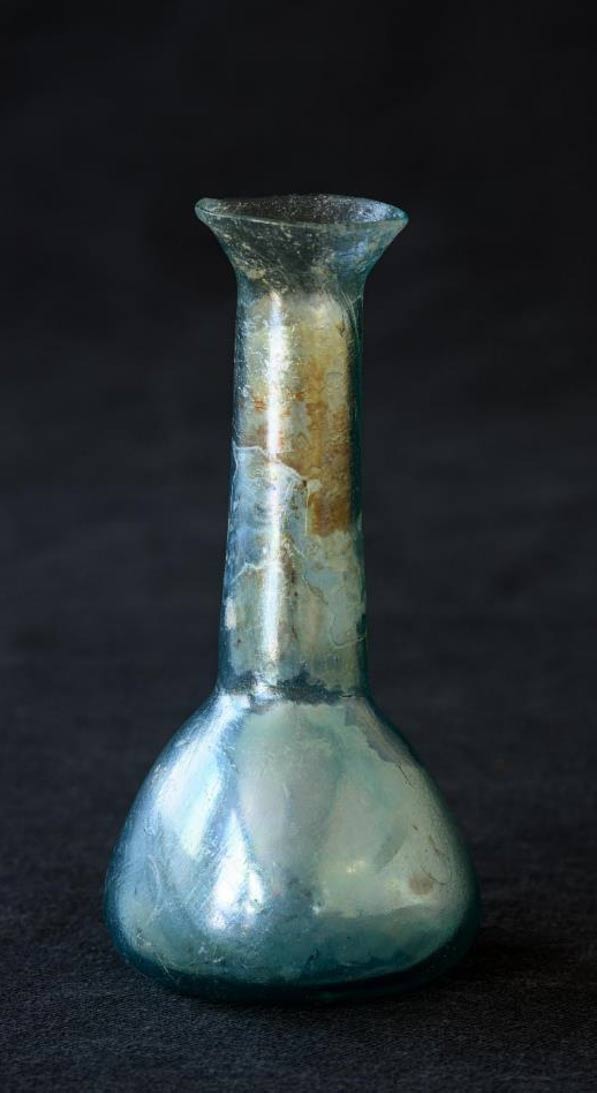
Roman Necropolis of "Regular Folk" Found in France
A magnificent Roman necropolis has been unearthed at Narbonne, in Occitaine, southwestern France. Archaeologists from the National Institute for Preventive Archaeological Research (INRAP) have reported on their excavations of the necropolis that was discovered beneath the gates of Narbonne and state that so far over 300 tombs have been found. The ancient burial ground covers half an acre and was actively used during the 1st and 2nd centuries.
Colonia Narbo Martius was founded in 118 BC on the Via Domitia, the first Roman road in Gaul linking Italy to the Iberian peninsula. As the first Roman colony in Gaul after Massalia (modern-day Marseille) was conquered by Caesar in 49 BC it became the capital of the province of Gallia Transalpina, later renamed “Gallia Narbonensis.” It was known for its prosperity and wealth.

Aerial view of a section of the Roman necropolis found in Narbonne, France. (Denis Gliksman, Inrap)
Assessing the Organic Evidence of the Roman Necropolis
The necropolis is situated about a third of a mile east of the ancient city’s perimeter at the crossroads of two Roman roads. It was designed in parcels of different architectural styles, with some tombs butting against each other while others are separated by service roads. What makes this discovery extra special is that the graves are “not” populated with the bodies of the social elite, but with those of common, everyday people.
- Arles Amphitheatre – A Roman Treasure in the Soul of Provence
- Early Christian Necropolis of Pécs: The Richest Collection of Sepulchral Monuments of the Roman Provinces
- The Cerveteri Necropolis, Etruscan City of the Dead
The tombs are generally characterized with small funerary monuments decorated with painted plaster and inscribed plaques detailing the entombed’s names, who are mostly of Italian origin. Archaeologists say they have found evidence of “widespread prosperity” among Narbo’s urban population. Most of the remains are cinerary, including burned bones and ashes on pyres in ceramic vessels often accompanied by delicate small bottles, ceramic jugs, and lamps. Among the ritualistic items recovered are charred organic burned offerings including figs and dates and also jewelry and phallic amulets.

A funerary plaque with the deceased’s name and epitaph. (Denis Gliksman, Inrap)
Floods Aren’t Always Bad
An Art Daily report says a tributary of the Aude river once flowed near the site and a series of floods deposited several layers of silt which have effectively enshrined and protected the ancient remains. The archaeologists excavated 10 feet (3.05 meters) into the alluvial silt and found each of the layers represented a different flood, which in turn sealed-in artifacts from different burial phases. However, this muddy chronological history book not only details the progressive use of the burial ground, but also the religious beliefs of the people and associated funerary customs and traditions.

Archaeologists found a type of perfume bottle that was frequently used in Roman funerary rituals. (Denis Gliksman, Inrap)
The site’s excellent state of preservation allows for a very clear picture of the rituals performed at funeral pyres and in the graves, and of the post-funeral memorial practices; which included offerings made in honor of the deceased and sometimes meals consumed within the burial enclosures. The researchers found that one-third of the graves were equipped with ceramic libation conduits (amphorae) which allowed for offerings to be made directly into the graves and small cups and shells were discovered that would have been used for pouring liquids into the conduits.
- Shackled adult and child skeletons unearthed in ancient Roman necropolis in France
- Mimes, Paid Grievers, and Masks: The Insane Theatrics of Ancient Roman Funerals
- Animal-bitten, Wounded, and Decapitated—Who were these Roman-era Men Buried near York?

A ceramic libation conduit which allowed for offerings to be made directly into the grave. (Denis Gliksman, Inrap)
The Elite of the Working Class
The archaeologists claim “libation conduits” are quite rare finds in Gaul until now, and through chemical analysis they hope to reveal exactly what the offerings were that the bereaved poured into the conduits. But it won’t have been mixtures of rare, exotic plants, herbs, and spices like what is found in the tombs of emperors and generals, but more likely everyday foods and drinks spared by the working class folks.
The sheer diversity of the funerary structures and artifacts and the tombs excellent states of preservation make this discovery unique not only in Gaul but across the Roman empire. And as a testimony to the site’s ‘elite’ status, it is already being considered as a primary data generator in the study of funerary practices of working-class people in Roman-occupied Gaul.
Top Image: Aerial view of the large Roman necropolis found in Narbonne, France. Source: Denis Gliksman, Inrap
By Ashley Cowie















